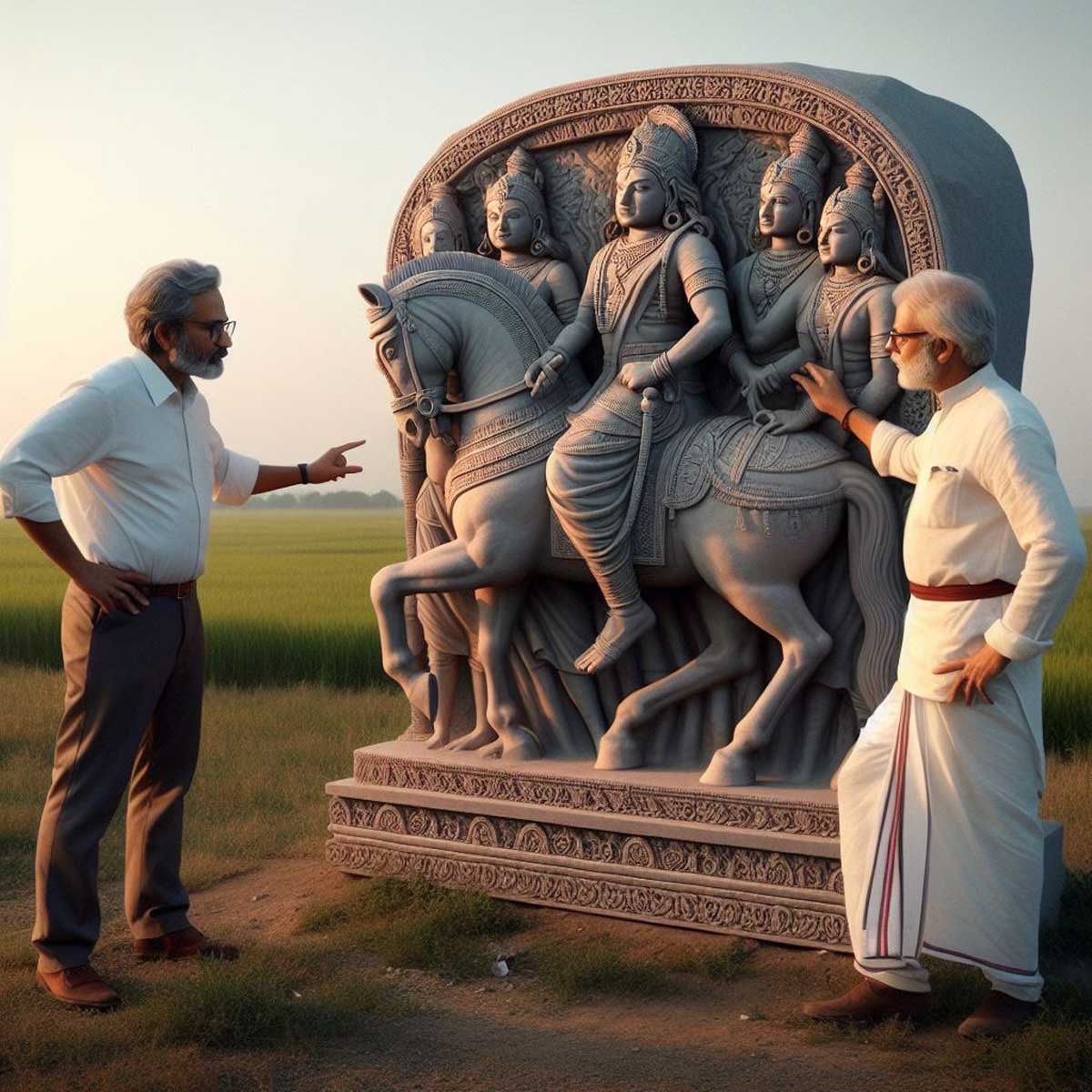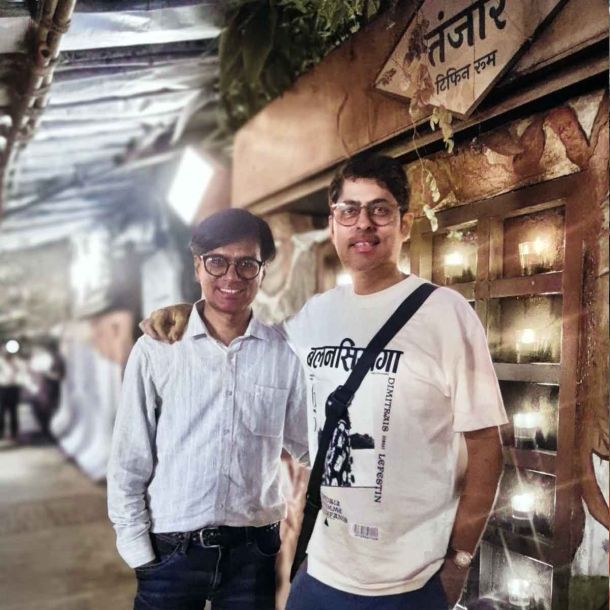More Coverage
Twitter Coverage
Satyaagrah
Written on
Satyaagrah
Written on
Satyaagrah
Written on
Satyaagrah
Written on
Satyaagrah
Written on
JOIN SATYAAGRAH SOCIAL MEDIA
"सनातन": In Tamil Nadu's fields, archaeologists uncover a 500-year-old Vijayanagara hero stone, depicting a valiant warrior in battle, echoing the rich legacy of an empire that profoundly sculpted the cultural and historical tapestry of Southern India

MADURAI: In a remarkable discovery that links us to our past, a 500-year-old stone sculpture from the era of the Vijayanagara Empire has been unearthed near Madurai, Tamil Nadu. This significant find adds to the growing list of historical artifacts that shed light on the rich cultural heritage of ancient Tamil Nadu, a land where the valor of heroes was immortalized in stone.
|
The tradition of erecting hero stones, known as 'Nadukal' in Tamil, has its roots deeply embedded in Tamil culture, a fact echoed by the age-old Sangam literature. These stones were traditionally set up to honor warriors who displayed extraordinary bravery, often commemorating their sacrifice in battles. This practice, prevalent in ancient Tamil Nadu, continues to captivate historians and archaeologists.
This latest find, a hero stone belonging to the Mesolithic period, was located in Nadukottai village, situated in the Madurai district. It was discovered almost accidentally by district archaeologists who were conducting a field visit. The visit was prompted by information provided by local residents, highlighting the crucial role of community involvement in preserving historical treasures.
The team, led by district archaeological officer M Ramesh and archaeological officer R Ajay Kumar, and under the guidance of the director of the Tamil Nadu State Archaeology Department, embarked on this exploration. Their efforts were rewarded when they found the hero stone amidst a dense thicket, located about a kilometer north of Nadukottai village. This location, nestled in the fields, proved to be a significant historical site.
The discovery, made on a Sunday, revealed that the hero stone found is one of the largest to be discovered in the district. Standing as a testament to the region's ancient and storied past, this stone sculpture is not just a piece of rock; it's a symbol of the valor and heroism that characterized the warriors of the Vijayanagara period. Its unearthing opens a new chapter in the understanding of the region's history, offering a tangible connection to the lives and stories of people who lived half a millennium ago.
Officer M Ramesh, who was instrumental in this discovery alongside archaeological officer R Ajay Kumar and Tamil Nadu archaeology department director R Sivanandam, provided insights into the stone's dimensions and future plans. "This hero stone is made of a granite slab and is five-and-a-half foot tall and four feet wide," Ramesh explained. They intend to transfer this historical artifact to the district museum soon, ensuring its preservation and accessibility for educational and research purposes.
Archaeologists underscore the vital role hero stones play in understanding ancient cultures. They are not just sculptures; they are historical documents in stone, offering a window into the life and culture of past civilizations. These stones narrate stories of warfare, illustrate dress and ornaments, depict weapons, and reveal customs, beliefs, and languages of various empires. While some hero stones are purely sculptural, others are inscribed with details about the hero's identity and the circumstances of their death, making them invaluable for historical study.
The hero stone discovered near Madurai is a vivid representation of a warrior from the Vijayanagara era. Ajay Kumar describes the scene depicted on the stone: "The stone...depicts a warrior riding a horse, the horse’s forelegs are raised and the warrior is seen holding a sword in his right hand while holding the horse’s reins in the left hand." The stone's craftsmanship is detailed and majestic, showcasing the warrior's twisted moustache, side crown, head-dress, earrings, and 'sannaveera' (armor) on the chest. The depiction is dynamic, with the warrior and horse portrayed in a lifelike, action-oriented posture. The bust of the warrior is drawn in a 'flying position,' a depiction that captures the essence of movement and the intensity of battle.
The description provided by the archaeological team offers a vivid picture of this historical piece. "In the panel, the warrior is carved in relief as he rides on a horse with its forelegs raised. The warrior’s raised right hand is shown carrying a sharp sword. The left hand is carved holding the reins of a horse," illustrates the dynamic and detailed portrayal of the warrior.
The figure of the warrior on the horse is depicted with remarkable detail, showcasing features characteristic of the Vijayanagara period's artistic style. The warrior sports a thick moustache, a detailed head-dress, a side bun, and earrings. He is also adorned with 'channaveera' (a type of armor) across his chest and has a dagger fastened around his waist. These elements are indicative of the traditional attire and armor of warriors from that era, as noted by the archaeologists.
Interestingly, the carving includes more than just the central figure of the warrior. To the left of the warrior, there is a depiction of a woman, likely his wife, adorned in ornaments and portrayed in a posture of reverence with her hands folded. Additionally, another male figure is shown holding an umbrella over the warrior, emphasizing the warrior’s stature and importance. Below the horse, the sculpture becomes even more intricate, with three male figures, each carrying a sword and a flask. These additional figures add depth and context to the scene, suggesting a story or a ceremony involving the central warrior figure.
R Sivanandam, the director of the Tamil Nadu archaeology department, remarks on the overall aesthetic of the piece: “The whole sculpture is beautifully presented under arches,” highlighting the architectural element in the sculpture’s design. The use of arched postures not only enhances the visual appeal of the sculpture but also reflects the architectural influences of the Vijayanagara period. This hero stone, with its detailed carvings and sophisticated design, offers a unique window into the art, culture, and society of the era it represents. Its discovery and subsequent study will undoubtedly enrich the understanding of India's historical and cultural heritage.
 |
Vijayanagara Empire: A Pivotal Chapter in Southern Indian History
The Vijayanagara Empire, also known as the Karnata Kingdom, was a formidable force in medieval Indian history, encompassing a vast region of Southern India. This empire, ruling from 1336 to 1646, covered the modern states of Karnataka, Andhra Pradesh, Tamil Nadu, Kerala, Goa, and parts of Telangana and Maharashtra. It was founded by Harihara I and Bukka Raya I of the Sangama dynasty, who were members of a pastoralist cowherd community claiming lineage from the Yadavas.
This empire emerged in response to the need for a strong southern power that could counter the Turco-Persian Muslim invasions at the end of the 13th century. The Vijayanagara Empire not only succeeded in this endeavor but also expanded its influence dramatically. At its zenith, it subdued nearly all ruling dynasties in Southern India, pushing the Turco-Persian sultans of the Deccan beyond the Tungabhadra-Krishna River doab region. Additionally, it annexed the Gajapati Empire in Odisha up to the Krishna River, cementing its status as a regional powerhouse.
The empire's prominence, however, began to wane following a significant military defeat at the Battle of Talikota in 1565, inflicted by the combined forces of the Deccan sultanates. This battle marked the beginning of the empire's decline, which lasted until its eventual dissolution in 1646.
|
The capital city of the empire, Vijayanagara, known today as Hampi, was a testament to the empire's grandeur and prosperity. The city's extensive ruins, a UNESCO World Heritage Site located in Karnataka, speak volumes of its historical significance. The empire's wealth and fame during its heyday attracted several medieval European travelers, including Domingo Paes, Fernão Nunes, and Niccolò de' Conti. Their accounts, along with contemporary literature, epigraphy in local languages, and modern archaeological excavations at Vijayanagara, have provided a wealth of information about the empire's history, culture, and power.
The Vijayanagara Empire, a significant force in medieval Southern India, left behind a legacy that continues to awe and inspire. Among its most notable contributions are the numerous monuments scattered throughout Southern India, with the group at Hampi being the most renowned. These architectural marvels are not just relics of the past; they are enduring symbols of the empire's grandeur and artistic prowess.
A key feature of the Vijayanagara Empire's architectural legacy was the innovative synthesis of different temple-building traditions from South and Central India. This fusion gave birth to the unique Vijayanagara architecture style, which brought about significant innovations in the construction of Hindu temples. These structures stand today as testaments to the empire's creativity and ingenuity in blending various artistic and architectural influences.
Beyond architecture, the empire's efficient administration and robust overseas trade introduced new technologies to the region. One such advancement was the development of sophisticated water management systems for irrigation, demonstrating the empire's foresight in resource management and agricultural development.
|
The Vijayanagara Empire was also a great patron of the arts and literature, which flourished under its reign. This patronage led to remarkable achievements in Kannada, Telugu, Tamil, and Sanskrit literature, covering diverse subjects such as astronomy, mathematics, medicine, fiction, musicology, historiography, and theater. These works enriched the cultural tapestry of the empire and continue to influence the region's intellectual and artistic landscape.
Significantly, the classical music of Southern India, known as Carnatic music, evolved into its current form during this period. This musical tradition, which is still vibrant and cherished today, owes much to the nurturing environment provided by the Vijayanagara Empire.
The empire's greatest contribution, however, may have been its role in transcending regionalism. By promoting Hinduism as a unifying factor, the Vijayanagara Empire created an epoch in the history of Southern India that transcended local identities and brought together diverse communities under a common cultural and religious canopy.
In essence, the Vijayanagara Empire's legacy is multifaceted – spanning architecture, technology, art, literature, and music – and it played a pivotal role in shaping the cultural and historical identity of Southern India. This legacy continues to be celebrated and preserved, reminding us of a time when innovation, creativity, and unity flourished under the banner of this mighty empire.
 Support Us
Support Us
Satyagraha was born from the heart of our land, with an undying aim to unveil the true essence of Bharat. It seeks to illuminate the hidden tales of our valiant freedom fighters and the rich chronicles that haven't yet sung their complete melody in the mainstream.
While platforms like NDTV and 'The Wire' effortlessly garner funds under the banner of safeguarding democracy, we at Satyagraha walk a different path. Our strength and resonance come from you. In this journey to weave a stronger Bharat, every little contribution amplifies our voice. Let's come together, contribute as you can, and champion the true spirit of our nation.
 |  |  |
| ICICI Bank of Satyaagrah | Razorpay Bank of Satyaagrah | PayPal Bank of Satyaagrah - For International Payments |
If all above doesn't work, then try the LINK below:
Please share the article on other platforms
DISCLAIMER: The author is solely responsible for the views expressed in this article. The author carries the responsibility for citing and/or licensing of images utilized within the text. The website also frequently uses non-commercial images for representational purposes only in line with the article. We are not responsible for the authenticity of such images. If some images have a copyright issue, we request the person/entity to contact us at This email address is being protected from spambots. You need JavaScript enabled to view it. and we will take the necessary actions to resolve the issue.
Related Articles
- Amarnath Ramakrishna’s Keeladi report sparked a storm as TN govt backed unverified dating claims, clashed with ASI over scientific standards, and politicized archaeology, turning a scholarly pursuit into a regional pride battle against the Centre
- Rajiv Gandhi overturned SC judgement protecting Muslim women’s right to maintenance during talaq: Shah Bano Case
- "Nak-Kati-Rani": Defying Shah Jahan, Rani Karnavati of Garhwal inflicted unprecedented humiliation on the Mughal army, cutting off their noses; her invincible spirit remain unsung in mainstream history, overshadowing the grand tales of emperors
- Saam Daam Dand Bhed: How Indira and Sanjay Gandhi pulled off the Maruti scam
- Vinayak Damodar Savarkar – A Misunderstood Legacy
- "Behold it is born. It is already sanctioned by the blood of martyred Indian youths": Madam Bhikhaiji Cama, the Brave lady to first hoist India’s flag on foreign Soil - Formative Years
- In a historical move ahead of Republic Day on January 26th, the Amar Jawan Jyoti flame at the India Gate would be merged with the flame at the National War Memorial on Friday
- The Forgotten Story of Rani Abbakka Chowta, the Fearless Warrior Queen of Tulu Nadu
- Khudiram Bose - The symbol of valiance and death-defying youth, an orphan at 7 to hanging by the British at 18
- "Achievement in space, politics on Earth": While ISRO's Chandrayaan-3 etches a new chapter in space history, the Congress's rush for credit speaks volumes, amidst lunar triumphs, memories of overlooked funding pleas during the UPA era cast long shadows
- "All violence, all that is dreary and repels, is not power, but the absence of power": Punkah - the hand operated ceiling fans of Colonial India and a reminder of how British colonials exploited ‘punkah-walas’ in India’s summers extracting constant labor
- Madras High Court: Do not take decision on melting Temple gold till Trustees are appointed
- Jhalkaribai: The Indian Rebellion Of 1857 Who Took on British Forces Disguised as Laxmibai
- "भूले तो नहीं": In 1860, the ship Truro & Belvedere brought 680 Indian indentured laborers to South Africa, beginning a journey of hardship that has since evolved into a thriving Indian community deeply embedded in South Africa's culture and history today
- Our first true war of independence lie forgotten within the fog of time and tomes of propaganda: Sanyasi Rebellion, when "renouncers of the material world" lead peasants in revolt against British and fundamentalist islamic clans




























